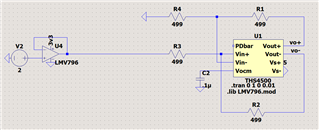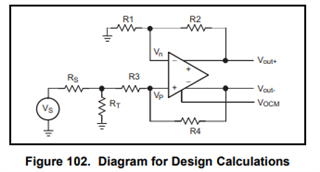Other Parts Discussed in Thread: THS4561, LMV796
I plan on using a buffer at V+ of THS4500 as shown below. 
Is a termination resistor before R3 necessary as specified in the datasheet? If so, how is the value determined in the absence of a source resistance? Lastly, the datasheet recommends having R3=487Ohms and R4 = 523 Ohms. However, when I work out the math (also confirmed by tests), I get a gain of ~0.93. Simulations and equations for an ideal diff amp show that R1=R4=R2=R3 should give a gain closer to 1. Is there something about THS4500 that I am getting wrong or are the test conditions in the datasheet different as suggested in the response to my previous question
example from the datasheet for reference.


